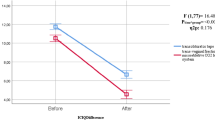Abstract
Introduction and hypothesis
Little data are available on the outcome of tension-free obturator tape (TVT-O) procedures in obese and overweight women. We hypothesized that the subjective and objective outcomes of TVT-O in women with a higher body mass index (BMI) would differ from those with a lower BMI.
Methods
We retrospectively reviewed the records of 129 patients who had undergone TVT-O, stratifying by BMI into normal weight (n = 39), overweight (n = 58), and obese (n = 32) groups. We compared pre- and postoperative evaluations, including subjective and objective outcome of TVT-O, complications, and quality of life assessed by validated questionnaires.
Results
The median follow-up was 24 months. There were no significant differences between groups in terms of objective cure rate and subjective success, quality of life scores, or postoperative complications.
Conclusion
BMI did not influence the outcome of TVT-O procedures at a median of 24 months after surgery.

Similar content being viewed by others
Abbreviations
- SUI:
-
Stress urinary incontinence
- TVT:
-
Tension-free vaginal tape
- TVT-O:
-
Tension-free vaginal tape obturator
- BMI:
-
Body mass index
- DO:
-
Detrusor overactivity
- UDI-6:
-
Urogenital Distress Inventory
- IIQ-7:
-
Incontinence Impact Questionnaire
References
Hunskaar S (2008) A systematic review of overweight and obesity as risk factors and targets for clinical intervention for urinary incontinence in women. Neurourol Urodyn 27:749–757
Greer WJ, Richter HE, Bartolucci AA, Burgio KL (2008) Obesity and pelvic floor disorders: a systematic review. Obstet Gynecol 112:341–349
de Leval J (2003) Novel surgical technique for the treatment of female stress urinary incontinence: transobturator vaginal tape inside-out. Eur Urol 44:724–730
Waltregny D, Gaspar Y, Reul O, Hamida W, Bonnet P, de Leval J (2008) TVT-O for the treatment of female stress urinary incontinence: results of a prospective study after a 3-year minimum follow-up. Eur Urol 53:401–408
Su TH, Huang WC, Lee MY, Lin TY, Chang HC, Chen CP (2009) Tension-free vaginal tape-obturator procedure for treatment of severe urodynamic stress incontinence: subjective and objective outcomes during 2 years of follow-up. J Obstet Gynaecol Res 35:1077–1082
Subak LL, Richter HE, Hunskaar S (2009) Obesity and urinary incontinence: epidemiology and clinical research update. J Urol 182:S2–S7
Bump RC, Mattiasson A, Bø K, Brubaker LP, DeLancey JO, Klarskov P et al (1996) The standardization of terminology of female pelvic organ prolapse and pelvic floor dysfunction. Am J Obstet Gynecol 175:10–17
WHO Expert Consultation (2004) Appropriate body mass index for Asian populations and its implications for policy and intervention strategies. Lancet 363:157–163
Blaivas JG, Appell RA, Fantl JA, Leach G, McGuire EJ, Resnick NM et al (1997) Definition and classification of urinary incontinence: recommendations of the Urodynamic Society. Neurourol Urodyn 16:149–151
Abrams P, Cardozo L, Fall M, Griffiths D, Rosier P, Ulmsten U et al (2002) The standardisation of terminology of lower urinary tract function: report from the Standardisation Sub-committee of the International Continence Society. Neurourol Urodyn 21:167–178
Uebersax JS, Wyman JF, Shumaker SA, McClish DK, Fantl JA (1995) Short forms to assess life quality and symptom distress for urinary incontinence in women: the incontinence impact questionnaire and the urogenital distress inventory. Continence program for women research group. Neurourol Urodyn 14:131–139
Noblett KL, Jensen JK, Ostergard DR (1997) The relationship of body mass index to intra-abdominal pressure as measured by multichannel cystometry. Int Urogynecol J Pelvic Floor Dysfunct 8:323–326
Hellberg D, Holmgren C, Lanner L, Nilsson S (2007) The very obese woman and the very old woman: tension-free vaginal tape for the treatment of stress urinary incontinence. Int Urogynecol J Pelvic Floor Dysfunct 18:423–429
Killingsworth LB, Wheeler TL 2nd, Burgio KL, Martirosian TE, Redden DT, Richter HE (2009) One-year outcomes of tension-free vaginal tape (TVT) mid-urethral slings in overweight and obese women. Int Urogynecol J Pelvic Floor Dysfunct 20:1103–1108
Skriapas K, Poulakis V, Dillenburg W, de Vries R, Witzsch U, Melekos M et al (2006) Tension-free vaginal tape (TVT) in morbidly obese patients with severe urodynamic stress incontinence as last option treatment. Eur Urol 49:544–550
Rechberger T, Futyma K, Jankiewicz K, Adamiak A, Bogusiewicz M, Skorupski P (2010) Body mass index does not influence the outcome of anti-incontinence surgery among women whereas menopausal status and ageing do: a randomised trial. Int Urogynecol J Pelvic Floor Dysfunct 21:801–806
Rafii A, Daraї E, Haab F, Samain E, Levardon M, Deval B (2003) Body mass index and outcome of tension-free vaginal tape. Eur Urol 43:288–292
Liapis A, Bakas P, Creatsas G (2010) Efficacy of inside-out transobturator vaginal tape (TVTO) at 4 years follow up. Eur J Obstet Gynecol Reprod Biol 148:199–201
Conflicts of interest
None.
Author information
Authors and Affiliations
Corresponding author
Rights and permissions
About this article
Cite this article
Liu, PE., Su, CH., Lau, HH. et al. Outcome of tension-free obturator tape procedures in obese and overweight women. Int Urogynecol J 22, 259–263 (2011). https://doi.org/10.1007/s00192-010-1311-1
Received:
Accepted:
Published:
Issue Date:
DOI: https://doi.org/10.1007/s00192-010-1311-1




